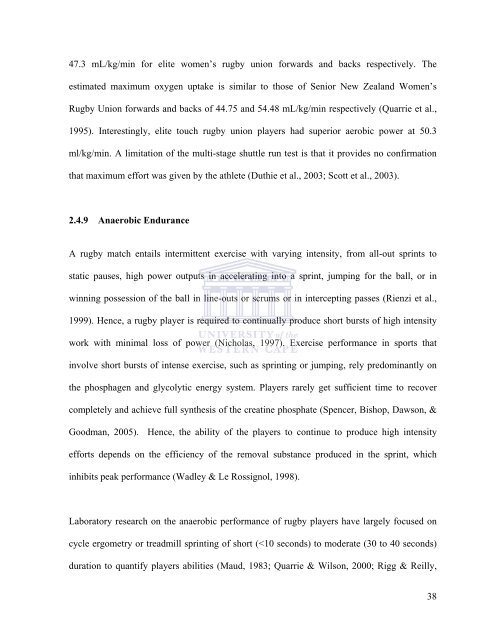Physical fitness of elite women's rugby union players over a ...
Physical fitness of elite women's rugby union players over a ...
Physical fitness of elite women's rugby union players over a ...
You also want an ePaper? Increase the reach of your titles
YUMPU automatically turns print PDFs into web optimized ePapers that Google loves.
47.3 mL/kg/min for <strong>elite</strong> women’s <strong>rugby</strong> <strong>union</strong> forwards and backs respectively. The<br />
estimated maximum oxygen uptake is similar to those <strong>of</strong> Senior New Zealand Women’s<br />
Rugby Union forwards and backs <strong>of</strong> 44.75 and 54.48 mL/kg/min respectively (Quarrie et al.,<br />
1995). Interestingly, <strong>elite</strong> touch <strong>rugby</strong> <strong>union</strong> <strong>players</strong> had superior aerobic power at 50.3<br />
ml/kg/min. A limitation <strong>of</strong> the multi-stage shuttle run test is that it provides no confirmation<br />
that maximum effort was given by the athlete (Duthie et al., 2003; Scott et al., 2003).<br />
2.4.9 Anaerobic Endurance<br />
A <strong>rugby</strong> match entails intermittent exercise with varying intensity, from all-out sprints to<br />
static pauses, high power outputs in accelerating into a sprint, jumping for the ball, or in<br />
winning possession <strong>of</strong> the ball in line-outs or scrums or in intercepting passes (Rienzi et al.,<br />
1999). Hence, a <strong>rugby</strong> player is required to continually produce short bursts <strong>of</strong> high intensity<br />
work with minimal loss <strong>of</strong> power (Nicholas, 1997). Exercise performance in sports that<br />
involve short bursts <strong>of</strong> intense exercise, such as sprinting or jumping, rely predominantly on<br />
the phosphagen and glycolytic energy system. Players rarely get sufficient time to rec<strong>over</strong><br />
completely and achieve full synthesis <strong>of</strong> the creatine phosphate (Spencer, Bishop, Dawson, &<br />
Goodman, 2005). Hence, the ability <strong>of</strong> the <strong>players</strong> to continue to produce high intensity<br />
efforts depends on the efficiency <strong>of</strong> the removal substance produced in the sprint, which<br />
inhibits peak performance (Wadley & Le Rossignol, 1998).<br />
Laboratory research on the anaerobic performance <strong>of</strong> <strong>rugby</strong> <strong>players</strong> have largely focused on<br />
cycle ergometry or treadmill sprinting <strong>of</strong> short (
















